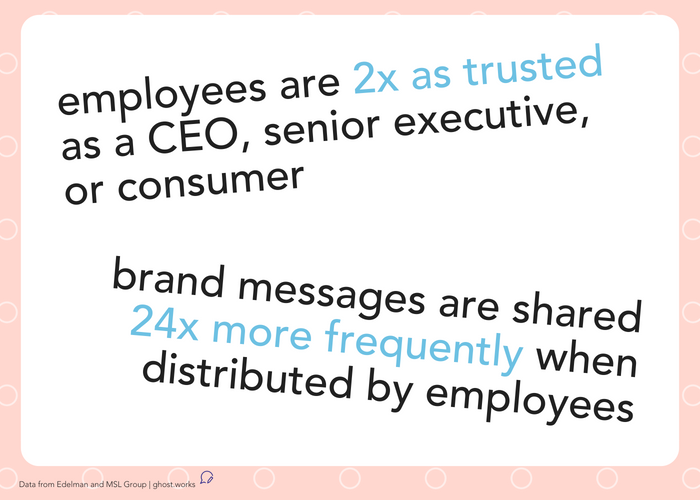All brand marketers are looking for affordable AND effective channels to evangelize their company’s messaging. Yet, some overlook an untapped brand marketing resource right before their eyes: employees and contractors.
This cohort has a vested interest in seeing the company succeed. And, if the culture is strong, this audience has a passion to share their love for the company where they work. Even if the culture leaves a little bit to be desired, a savvy brand marketer or corporate communications professional will engage this group.
When done right, investing in this audience delivers dividends over time. Employees become part of a strategy to disseminate content and share brand values — all without spending much money.
Think of this as internal influencer marketing!
Identify internal influencers
Every community has influencers. Companies are no different. There will be thought leaders in each department, and oftentimes they’re not the people that you would expect. Make a list of those that you consider internal influencers and then methodically test this initial list against your own bias.
Consider things like social media presence, participation in company initiatives, activity on the company intranet, and contributions to external professional and community organizations. As a rule of thumb, you want to look for someone who has an engaging presence that other people respond to. It’s those kinds of people that Internal communications initiatives hinge on.

Segment smartly
Now that you’ve verified your internal influencer list, it’s time to segment. This stuff is often overlooked — because there’s never enough time. It seems slightly unnecessary and is an easy one to ignore when the to-do list is long.
However, we don’t recommend skipping this step. Ignoring the fact that different segments have different needs is dangerous. Without proper segmentation, the initiative is likely to fail. This is because the content cannot be effectively targeted to the right segment.
Remember that the goal is to match brand messages with internal influencers that are most likely to share them. And then once was messages are shared, those who follow those influencers will ideally engage with them. So if the message is not targeted to the individual, then the person who follows that individual is also less likely to engage.
Each organization will have its own segmentation. You might want to segment by department, by function, or by geography. Or perhaps you want to do it by which channel the influencers are most engaged with. This creates interesting opportunities to bring together those internal influencers who are very popular on Twitter, for example. This fosters a new type of community and the company, which encourages others to be active on these types of social platforms. By giving influencers a voice in the process, you foster ownership and increase the chances of success.
Assign a channels strategy to each segment
What’s you have your segments, you’ll have a pretty clear idea about which digital channels work best for those segments. You also should have some insights into which you might want to experiment with, such as increasing employee use of mobile apps or using a chatbot to engage with employees. In the most recent Gatehouse study, the majority of respondents were aiming to increase usage of mobile tools by employees, for example.

Data from Gatehouse 2018’s report on internal comms.
The reason for this step is that you want representation of influencers across the different channels you’re looking to engage with. This helps disseminate the content across as many channels as possible, increasing the ROI on content already created. It’s important to recognize that not all digital channels are created equally, just like all influencers are not the same.
Offer perks
While gamification and leaderboards have dropped out of favor, there is still a place for healthy competition in the workplace. Consider deploying tools, such as EveryoneSocial, that automate much of this employee engagement. These tools can help you segment as well, saving time and making it easier for you to push out different types of content with the employees. These types of programs are solid extensions of an existing company Internet.
Remember that any perks you offer must be managed. So if you’re going to do a leaderboard, especially via vendor, you’ll need to allot resources to manage the project. You can offer other perks, just be sure that you deliver those perks accurately as promised and on time. Disillusionment is easy when promises are made and not kept. Take pictures of any perks earned by employees — and promote those as well!
Sometimes a perk is simply an acknowledgment. Whether via the company intranet or a companywide announcement, acknowledging those who are strong advocates for the brand sets an example for the rest.
Bonus points if you can convince your executives to lead by example and develop strong sharing sensibilities across the most important digital channels. Gallup found that only 13% of employees strongly agree that their leaders are effectively communicating with the organization — a cogent strategy that involves leaders could provide organizational benefits beyond free distribution for your brand marketing messages!
And…don’t forget your customers!
Sales enablement often gets all the attention when it comes to creating content that converts potential customers. But don’t forget your existing customers! They can be a fantastic resource for sharing content, and generally evangelizing your brand.
Whether it’s creating an official ambassador program, or simply emailing relevant articles for sharing, craft a strategy that works for your company. Clients are usually more than happy to share content from companies they love, especially if the company is responsive and relationship-oriented.
When it comes down to brand marketing, it’s about engaging those who care the most to disseminate the messages that matter the most. Take the time to invest in a program upfront, and the return on this minimal investment will only grow over time!
